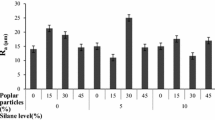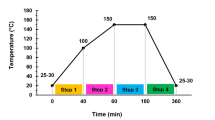Abstract
There are two main possibilities to substitute conventional wood material in the panel production: the use of wood of fast-growing trees plantations and/or the use of alternative ligno-cellulosic raw materials. Especially particleboards produced from the ‘‘energetic’’ willow present the same or better mechanical parameters compared to particleboards conventionally produced mainly from soft woods. Increasing bio-fuel production, mostly from rape, will cause an escalation of the rape cultivation area and, as a result, will augment the amount of waste (rape straw) to be utilized. The aim of this study was to verify the friction coefficient of the new board types in tribological contact with tools surfaces. The investigations were performed in situ. The results of the friction coefficient related to the tools surfaces as well as lingo-cellulose materials are presented.
Zusammenfassung
Bei der Herstellung von plattenförmigen Holzwerkstoffen kann das herkömmliche Holzmaterial im Wesentlichen auf zwei Arten ersetzt werden: entweder durch Holz aus Schnellwuchsplantagen oder alternativen Lignocellulosen. Im Vergleich zu den herkömmlichen, überwiegend aus Nadelholz hergestellten Spanplatten weisen Platten aus dem für energetische Verwendung gedachtem Weidenholz gleiche oder bessere mechanische Eigenschaften auf. Die Produktion von Biobrennstoff, vor allem aus Raps, gewinnt zunehmend an Bedeutung, und wird zu steigenden Rapsanbauflächen führen, wodurch sich wiederum die Menge an nutzbaren Reststoffen (Rapsstroh) erhöhen wird. In dieser Studie soll der Reibungskoeffizient der neuen Plattentypen zwischen der Platte und den Werkzeugoberflächen bestimmt werden. Die Untersuchungen wurden in situ durchgeführt. Die Reibungskoeffizienten in Abhängigkeit der Werkzeugoberflächen und der lignozellulosen Materialien werden dargestellt.
Similar content being viewed by others
References
Beer P (2005) In situ examinations of the friction properties of chromium coated tools in contact with wet wood. Tribol Lett 18(3):373–376
Beer P, Gogolewski P, Klimke J, Krell A (2007) Tribological Behaviour of Sub-Micron Cutting-Ceramics in Contact with Wood-based Materials. Tribol Lett 27:155–158
Butaud JC, Decès-Petit C, Marchal R (1995) Proc. An experimental device for study of wood cutting mechanisms: the microlathe. 12th IWMS, Kyoto, Japan, pp 479–485
Djouadi MA, Beer P, Marchal R, Sokolowska A, Lambertin M, Precht W, Nouveau C (1999) Antiabrasive coatings: application for wood processing. Surf Coat Technol 116–119:508–516
Frackowiak I (2004) From the investigations on the utilization of the alternative lignocellulose raw materials to particleboards production (in Polish). DREWNO-WOOD 47(171):31–48
Kowaluk G, Frackowiak I, Beer P, Palubicki B, Szymanski W (2007) Comparison of the tool wear in milling of the particleboards produced from wood and rape straw. Proc. of the 3rd ISWM, Lausanne, pp 47–50
Kragielsky IV, Dobychin MN, Konbalov VS (1982) Friction and Wear – Calculation Methods. Pergamon Press Ltd.
McKenzie WM (1991) Friction coefficient as a guide to optimum rake angle in wood machining. Wood Sci Technol 25:397–401
McKenzie WM, Karpovich H (1968) The frictional behaviour of wood. Wood Sci Technol 2:139–152
McKenzie WM, Ko P, Cvitkovic R, Ringler M (2001) Towards a model predicting cutting forces and surface quality in routing layered boards. Wood Sci Technol 35:563–569
Niedzielski P, Miklaszewski S, Beer P, Sokolowska A (2001) Tribological properties of NDC coated cemented carbides in contact with wood. Diam Relat Mater 10:1–6
Author information
Authors and Affiliations
Corresponding author
Rights and permissions
About this article
Cite this article
Kowaluk, G., Palubicki, B., Frackowiak, I. et al. Influence of ligno-cellulosic particles on tribological properties of boards . Eur. J. Wood Prod. 68, 95–98 (2010). https://doi.org/10.1007/s00107-009-0362-9
Received:
Published:
Issue Date:
DOI: https://doi.org/10.1007/s00107-009-0362-9




